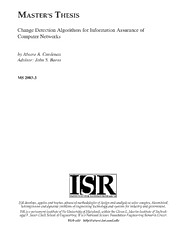
DTIC ADA438668: Change Detection Algorithms for Information Assurance of Computer Networks PDF
Preview DTIC ADA438668: Change Detection Algorithms for Information Assurance of Computer Networks
M T ASTER'S HESIS Change Detection Algorithms for Information Assurance of Computer Networks by Alvaro A. Cardenas Advisor: John S. Baras MS 2003-3 I R INSTITUTE FOR SYSTEMS RESEARCH ISR develops, applies and teaches advanced methodologies of design and analysis to solve complex, hierarchical, heterogeneous and dynamic problems of engineering technology and systems for industry and government. ISR is a permanent institute of the University of Maryland, within the Glenn L. Martin Institute of Technol- ogy/A. James Clark School of Engineering. It is a National Science Foundation Engineering Research Center. Web site http://www.isr.umd.edu Report Documentation Page Form Approved OMB No. 0704-0188 Public reporting burden for the collection of information is estimated to average 1 hour per response, including the time for reviewing instructions, searching existing data sources, gathering and maintaining the data needed, and completing and reviewing the collection of information. Send comments regarding this burden estimate or any other aspect of this collection of information, including suggestions for reducing this burden, to Washington Headquarters Services, Directorate for Information Operations and Reports, 1215 Jefferson Davis Highway, Suite 1204, Arlington VA 22202-4302. Respondents should be aware that notwithstanding any other provision of law, no person shall be subject to a penalty for failing to comply with a collection of information if it does not display a currently valid OMB control number. 1. REPORT DATE 3. DATES COVERED 2003 2. REPORT TYPE - 4. TITLE AND SUBTITLE 5a. CONTRACT NUMBER Change Detection Algorithms for Information Assurance of Computer 5b. GRANT NUMBER Networks 5c. PROGRAM ELEMENT NUMBER 6. AUTHOR(S) 5d. PROJECT NUMBER 5e. TASK NUMBER 5f. WORK UNIT NUMBER 7. PERFORMING ORGANIZATION NAME(S) AND ADDRESS(ES) 8. PERFORMING ORGANIZATION Army Research Office,PO Box 12211,Research Triangle Park,NC,27709 REPORT NUMBER 9. SPONSORING/MONITORING AGENCY NAME(S) AND ADDRESS(ES) 10. SPONSOR/MONITOR’S ACRONYM(S) 11. SPONSOR/MONITOR’S REPORT NUMBER(S) 12. DISTRIBUTION/AVAILABILITY STATEMENT Approved for public release; distribution unlimited 13. SUPPLEMENTARY NOTES The original document contains color images. 14. ABSTRACT see report 15. SUBJECT TERMS 16. SECURITY CLASSIFICATION OF: 17. LIMITATION OF 18. NUMBER 19a. NAME OF ABSTRACT OF PAGES RESPONSIBLE PERSON a. REPORT b. ABSTRACT c. THIS PAGE 99 unclassified unclassified unclassified Standard Form 298 (Rev. 8-98) Prescribed by ANSI Std Z39-18 ABSTRACT Title of Thesis: CHANGE DETECTION ALGORITHMS FOR IN- FORMATION ASSURANCE OF COMPUTER NET- WORKS Degree candidate: Alvaro A. Cardenas Degree and year: Master of Science, 2002 Thesis directed by: Professor John S. Baras Department of Electrical Engineering As our reliance on computer networks grows, the need for better and more ac- curate intrusion detection systems to identify and contain attackers becomes a fundamental research topic. In this thesis we will focus on the detection of three attack scenarios: spreading of active worms throught the Internet, distributed denial of service attacks and routing attacks to wireless ad hoc networks. For the first two attacks we will determine anomalouschanges inthe network flow. Forthe thirdattack, we provide anabstract representation of a highly mobile adhocnetwork in order to establish a baseline for detecting abnormalities generated by intrusions changing the behavior of the routing protocol. We consider these problems in the framework of sequential change detection theory as we want to detect the appearance of an attack early in its development. CHANGE DETECTION ALGORITHMS FOR INFORMATION ASSURANCE OF COMPUTER NETWORKS by Alvaro A. Cardenas Thesis submitted to the Faculty of the Graduate School of the University of Maryland, College Park in partial fulfillment of the requirements for the degree of Master of Science 2002 Advisory Committee: Professor John S. Baras, Chair Professor Eyad H. Abed Professor William S. Levine (cid:1)c Copyright by Alvaro A. Cardenas 2002 DEDICATION To my grandmother Delfina. ii ACKNOWLEDGMENTS I am grateful to my advisor, Professor John S. Baras for his support. I would also like to thank Dr. Eyad Abed and Dr. William S. Levine for agreeing to serve on my committee and review the thesis. I am in particular indebted to Dr. Vahid Ramezani, Svetlana Radosavac, Karthikeyan Chandrasekar, Tao Jiang, Marco Alzate and all my colleagues in the SEIL lab and the CSHCN for their suggestions and support. Iamgratefulfor thesupport of my research work and graduatestudies through the following contracts and grants (all with the University of Maryland College Park): ARO DAAD190110494, ONR N000149710501EE and a graduate school fellowship iii TABLE OF CONTENTS List of Tables vii List of Figures viii 1 Introduction 1 1.1 Intrusion Detection . . . . . . . . . . . . . . . . . . . . . . . . . . . 1 1.2 Change Detection Algorithms . . . . . . . . . . . . . . . . . . . . . 1 1.2.1 Sequential detection . . . . . . . . . . . . . . . . . . . . . . 2 1.2.2 Optimal change detection algorithms . . . . . . . . . . . . . 3 1.2.2.1 CUSUM algorithm . . . . . . . . . . . . . . . . . . 4 1.2.2.2 Shiryaev-Roberts statistic . . . . . . . . . . . . . . 4 1.2.2.3 Algorithm with a prior of the change time . . . . . 5 1.2.3 Nonparametric CUSUM and Gishik-Rubin-Shiryaev Statistics 5 1.2.4 GLR for composite hypothesis and nuisance parameters . . . 6 1.3 Network definitions and algorithms . . . . . . . . . . . . . . . . . . 7 2 Worm Detection 9 2.1 Description of the Attack . . . . . . . . . . . . . . . . . . . . . . . . 9 iv
